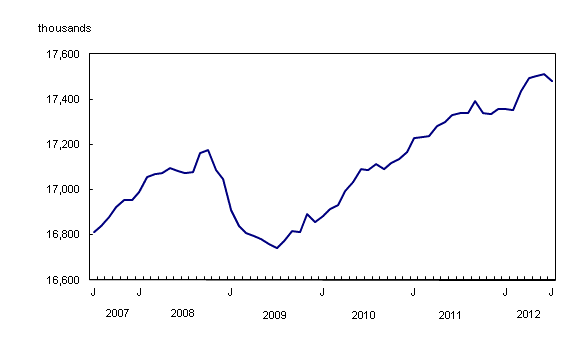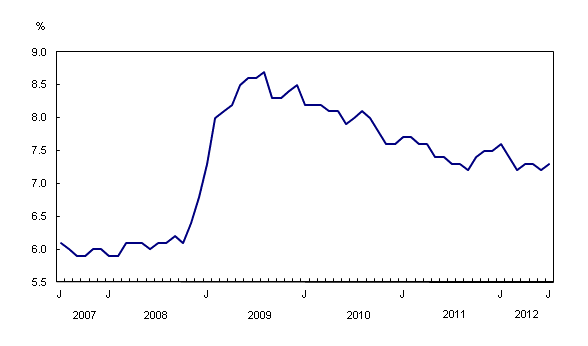Labour Force Survey, July 2012
Archived Content
Information identified as archived is provided for reference, research or recordkeeping purposes. It is not subject to the Government of Canada Web Standards and has not been altered or updated since it was archived. Please "contact us" to request a format other than those available.
Related subjects
-
[an error occurred while processing this directive]
Following two months of little change, employment in July declined by 30,000, the result of losses in part-time work. The unemployment rate rose 0.1 percentage points to 7.3%.
Compared with 12 months earlier, employment increased 0.8% or 139,000, with full-time employment up 1.4% while part-time employment declined 1.8%. Total number of hours worked increased 1.2% over the same period.
Employment

Employment losses in July were in wholesale and retail trade; professional, scientific and technical services; public administration; and natural resources. These losses were partly offset by gains in information, culture and recreation as well as in finance, insurance, real estate and leasing.
In July, employment declined in Quebec, British Columbia, Manitoba as well as in Newfoundland and Labrador, while it increased in Prince Edward Island. There was little change in the other provinces.
Losses were concentrated among women aged 55 and over, while employment was virtually unchanged among the other major demographic groups.
There was little change in employment in both the public and private sectors in July. Compared with 12 months earlier, employment in the public sector increased by 2.1%, while private sector employees and self-employment were little changed.
Unemployment rate

Chart description: Unemployment rate
Industry perspective
Employment in wholesale and retail trade decreased by 30,000 in July. Compared with 12 months earlier, employment in this sector has fallen by 88,000 (-3.3%).
In July, employment in professional, scientific and technical services declined by 22,000, continuing its downward trend that started in January. Compared with 12 months earlier, employment was little changed in this sector, as the recent declines were offset by gains in the first five months of this period.
Employment in public administration fell by 17,000 in July. Employment in this sector remained similar to 12 months earlier.
Employment in natural resources declined by 8,900 in July, following two months of little change. Nonetheless, this sector continued to have the highest year-over-year growth rate of all major industries at 11.4%.
In July, employment rose by 24,000 in information, culture and recreation, following declines in the previous three months. Compared with 12 months earlier, employment in this sector remained little changed.
Employment in finance, insurance, real estate and leasing increased by 19,000 in July, continuing an upward trend that started in February. These gains offset declines in the previous five months, leaving employment in July similar to that of 12 months earlier.
Manufacturing was little changed in July, following gains earlier in the year. Compared with 12 months earlier, the number of factory workers was up slightly.
Provincial summary
Employment in Quebec fell by 29,000 in July, all in part-time work, leaving employment at similar levels to July 2011. The unemployment rate for the month was 7.6%.
Following two months of little change, employment in British Columbia declined by 15,000 in July, pushing the unemployment rate up 0.4 percentage points to 7.0%. With gains made prior to May, employment in this province was 1.5% higher compared with 12 months earlier.
In July, employment in Manitoba declined by 3,300 and the unemployment rate increased by 0.5 percentage points to 5.7%. Compared with 12 months earlier, employment was little changed.
Employment in Newfoundland and Labrador was down 3,200 in July, leaving employment at a similar level as July 2011.
Following gains in June, employment in Ontario was little changed in July. The unemployment rate rose 0.2 percentage points to 7.9%, as more people searched for work. Year-over-year employment gains totalled 47,000 (+0.7%).
Despite little change in employment for the second consecutive month, Alberta continued to have the lowest unemployment rate among all the provinces at 4.6%. With gains made throughout most of the previous 12 months, employment in this province has increased by 2.2% since July 2011, the highest growth rate of all provinces.
Employment declines among women aged 55 and over
Following three months of little change, employment among women aged 55 and over fell by 30,000 in July. Nevertheless, compared with 12 months earlier employment among this group was up by 45,000 (+3.2%).
Despite little change for men aged 55 and over in July, their employment was up 72,000 (+4.3%) compared with 12 months earlier.
The year-over-year employment increase for both men and women aged 55 and over was mostly a result of population aging.
Employment among those aged 25 to 54 was virtually unchanged in July. Employment growth for this group over the previous 12 months totalled 74,000 (+0.6%).
Employment among youths was little changed in July, and was down by 52,000 (-2.1%) compared with 12 months earlier. Their unemployment rate declined by 0.5 percentage points to 14.3% in July, as fewer of them searched for work.
Student summer employment
From May to August, the Labour Force Survey collects labour market information about young people aged 15 to 24 who were attending school full time in March and intend to return to school full time in the fall. The published estimates are not seasonally adjusted; therefore, comparisons can only be made on a year-over-year basis.
The rate of employment among students aged 20 to 24, that is, the number of employed as a percentage of their population, was 70.4% in July, little changed from the previous two years, but up from 66.8% in July 2009, when student employment was hard hit by the labour market downturn. The unemployment rate for these students was 7.9% in July, similar to that of the previous two years but down from 13.3% in July 2009.
Among students aged 17 to 19, the employment rate of 58.7% in July has been essentially unchanged since July 2009. Their unemployment rate, at 17.7%, has also been little changed since July 2009.
The labour market for students aged 15 to 16 years continued to be difficult in July. Their employment rate was 29.0%, the lowest on record. The unemployment rate for these students was 31.2%, among the highest ever posted for this age group.
Note to readers
The Labour Force Survey (LFS) estimates are based on a sample and are therefore subject to sampling variability. Estimates for smaller geographic areas or industries will have more variability. For an explanation of sampling variability of estimates and how to use standard errors to assess this variability, consult the "Data quality" section of the publication Labour Force Information (Catalogue number71-001-X, free).
The employment rate is the number of employed persons as a percentage of the population 15 years of age and over. The rate for a particular group (for example, youth aged 15 to 24) is the number employed in that group as a percentage of the population for that group.
The unemployment rate is the number unemployed as a percentage of the labour force (employed and unemployed).
The participation rate is the number of employed and unemployed as a percentage of the population. For more detailed information, see the Guide to the Labour Force Survey (Catalogue number71-543-G, free).
Unless otherwise stated, this release presents seasonally adjusted data, which facilitates comparisons by removing the effects of seasonal variations. For more information on seasonal adjustment, see Seasonal adjustment and identifying economic trends.
Educational services
The LFS seasonal adjustment process removes typical seasonal patterns in the monthly data, according to trends established in previous years. While there have been larger movements in educational services employment in summer months in recent years, there has not been a consistent pattern in the magnitude or direction of these changes.
Available without charge in CANSIM: tables CANSIM table282-0001 to 282-0042, CANSIM table282-0047 to 282-0063, CANSIM table282-0069 to 282-0095, CANSIM table282-0100 to 282-0121 and CANSIM table282-0200 to 282-0219.
Definitions, data sources and methods: survey number survey number3701.
A more detailed summary, Labour Force Information (Catalogue number71-001-X, free), is now available online for the week ending July 21. From the Key resource module of our website under Publications, choose All subjects, then Labour.
Data tables are also now available online. From the Subject module of our website, choose Labour.
The next release of the Labour Force Survey will be on September 7.
For more information, contact Statistics Canada's National Contact Centre (toll-free 1-800-263-1136; 613-951-8116; infostats@statcan.gc.ca).
To enquire about the concepts, methods or data quality of this release, contact Jason Gilmore (613-951-7118; jason.gilmore@statcan.gc.ca) or May Luong (613-951-6014; may.luong@statcan.gc.ca), Labour Statistics Division.
- Date modified:
